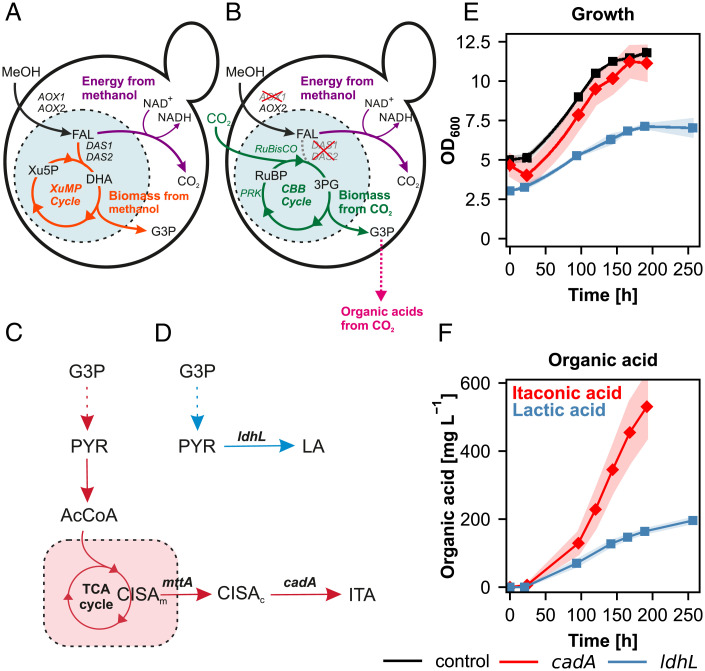Fig. 1.
Expression of cadA and ldhL enables organic acid production in synthetic autotrophic K. phaffii. (A–D) Schematic pathways. (A) In wild-type K. phaffii methanol is oxidized to formaldehyde (black arrow) and assimilated in the XuMP cycle (orange arrows) or dissimilated to CO2, respectively (purple arrow). (B) synthetic autotrophy in K. phaffii: the native assimilatory branch of methanol utilization was interrupted by deleting DAS1 and DAS2 (dashed gray line). AOX1 was knocked out to reduce the rate of formaldehyde formation which could be toxic to the cells. RuBisCO and PRK were integrated to complete a functional CBB cycle (green arrows). Additionally, two bacterial chaperones, groEL and groES, were overexpressed to assist the folding of RuBisCO. TDH3, PGK1, TKL1, TPI1 carrying each a peroxisomal targeting signal were overexpressed to assure the localization of the entire CBB cycle in peroxisomes. More details about the engineering strategy can be found in ref. (13). (C) Itaconic acid (red) and (D) lactic acid production (blue), (E) growth profiles, and (F) organic acid production profiles of the producing strains and the control. Time axis corresponds to the production phase under autotrophic conditions. At least three biological replicates were used in the screening to monitor the producing strains. Shades represent the SDs (±). 3PG: 3-phosphoglycerate, AcCoA: acetyl-coenzyme A, AOX1 and AOX2: alcohol oxidase 1 and 2, cadA: cis-aconitate decarboxylase, CBB cycle: Calvin-Benson-Bassham cycle, CISAc: cytosolic cis-aconitate, CISAm: mitochondrial cis-aconitate, DAS1 and DAS2: dihydroxyacetone synthase 1 and 2, DHA: dihydroxyacetone, FAL: formaldehyde, G3P: glyceraldehyde 3-phosphate, ITA: itaconic acid, LA: lactic acid, ldhL: L-lactate dehydrogenase, MeOH: methanol, mttA: mitochondrial tricarboxylic acid transporter, NAD+/NADH: nicotinamide adenine dinucleotide, PRK: phosphoribulokinase, PYR: pyruvate, RuBP: ribulose 1,5-bisphosphate, RuBisCO: ribulose 1,5-bisphosphate carboxylase/oxygenase, Xu5P: xylulose 5-phosphate, XuMP cycle: xylulose monophosphate cycle.

